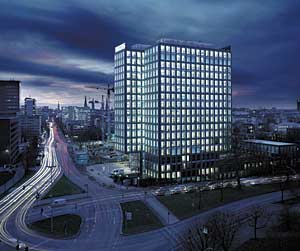Acrylic Foam Structural Glazing Tape: A New Bonding Alternative
Specifications Best Practices
 Philips Headquarters in Hamburg, Germany. Acrylic foam structural glazing tape was used to bond 2,400 glazed panels. Photo: Oliver Heissner |
|
When evaluating new products for design and specification, architects should review available information carefully, including independent third party technical testing data documenting structural capacity, weathering capability, and longevity. They should investigate other installations and applications, as well as project types, testing performed, and the results. Other important considerations are installation procedures, appearance, direct and indirect costs, and warranties. Manufacturers should ideally provide technical advice and support for questions that may arise, especially during the design and construction phases.
When, in the late 1990s, Terry Bell, AIA, partner, Gehry Partners, LLP, began researching acrylic foam tape for bonding exterior stainless steel panels to stiffeners and aluminum frame for the Disney Concert Hall, he talked to users in other fields, did in-house research, laboratory testing, and built full size mock-ups. (He recalls the difficulty of removing the tape from panels when disassembling the performance mockup in Miami). The benefits of the tape, aside from its high bond strength, he says, include allowing for differential lateral thermal movement of the stainless steel panels and the aluminum sub-frame, preventing telegraphing of the framing locations onto the panel, and being able to handle materials immediately after bonding.
International Applications of Acrylic Foam Structural Glazing Tape
Acrylic foam structural glazing tape has many structural glazing applications across several continents in various climates and construction environments.
Since 1990, acrylic foam structural glazing tape has performed in hot and cool, high humidity and UV conditions in more than 2,500 projects in Brazil. Among them, a building for Aché, the largest pharmaceutical laboratory in the country, hotels, and office towers. It was used for an office tower in Guatemala in 1994 under similar climatic conditions, and in several projects in Mexico where pollution added to the challenges of heat and UV. In Austria's cold, hot and humid climate, the tape was employed on a project completed in 1999, and in Portugal, met Portuguese building codes for a tower constructed in 2002. Four major projects were completed in Israel in 2003. And in 2005, the tape complied with Germany's rigorous building code requirements for glazing 2400 glass panels for Philips Headquarters in Hamburg.
|
|










